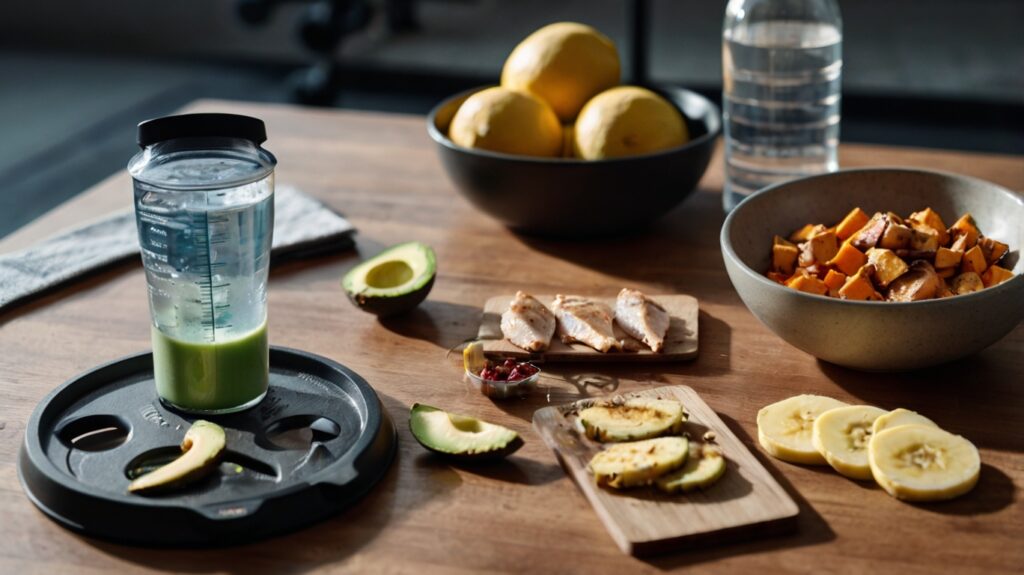Ever stared at your reflection, wondering why those hours on the treadmill aren’t showing results? You’re not alone. A staggering 67% of gym-goers abandon their fitness journey because they’re doing it wrong.
I’m about to flip your workout world upside down with full body workout tips that actually deliver.
Look, I’ve been where you are. Spinning my wheels, following celebrity workouts, wondering why my body wasn’t changing. Then I discovered the science of integrated training and everything clicked.
The problem isn’t your commitment—it’s your approach. When you understand how your muscles actually work together, not as isolated parts, that’s when the magic happens.
But here’s what nobody tells you about full body workouts that could triple your results overnight…
The Science Behind Effective Full Body Workouts
How Complete Routines Accelerate Metabolism
Ever wonder why you’re still burning calories hours after a full body workout? That’s your metabolism working overtime. Full body routines trigger what fitness pros call the “afterburn effect” – technically EPOC (Excess Post-exercise Oxygen Consumption).
When you hit multiple muscle groups in one session, your body needs more energy to repair all those worked muscles. This cranks up your calorie-burning furnace for up to 48 hours post-workout. Pretty sweet deal, right?
Compare that to isolated exercises where you might burn 200-300 calories during a workout. A proper full body session can lead to burning an additional 400+ calories afterward while you’re just chilling on the couch!
Muscle Synergy: Why Working Multiple Groups Matters
Your body wasn’t designed to work in isolation – it functions as a team.
Think about it: when do you ever just use your biceps in real life? Exactly. Never.
When you perform compound movements like squats, deadlifts, or rowing, you’re training your muscles to work together, creating functional strength that actually helps in everyday life.
This synergy doesn’t just build better-looking muscles – it builds usable strength. Your core stabilizes while your legs drive and your arms pull. This coordination translates to everything from carrying groceries to playing with your kids without getting winded.
Hormonal Benefits of Compound Exercises
The secret sauce of full body workouts? Hormones.
Compound exercises trigger a massive release of testosterone and growth hormone – your body’s natural muscle-building, fat-burning cocktail. Single-joint exercises simply can’t compete here.
A 2018 study found that doing squats produced 200% more growth hormone than leg extensions for the same perceived effort. That’s like getting triple the results for the same time investment.
These hormones don’t just help your muscles – they improve bone density, enhance recovery, and even boost your mood. Talk about a win-win-win situation.
Recovery Optimization for Maximum Results
The biggest mistake people make isn’t working too little – it’s not recovering enough.
Your muscles don’t grow during workouts; they grow during rest. A well-designed full body routine respects this by strategically spacing workouts 48-72 hours apart, giving your body the perfect window to repair and grow stronger.
Smart recovery isn’t just about rest days. It’s about:
- Quality sleep (aim for 7-9 hours)
- Proper hydration (minimum half your body weight in ounces)
- Protein timing (get 20-30g within 30 minutes post-workout)
- Stress management (high stress = low gains)
Master these recovery elements, and you’ll break through plateaus you thought were permanent.
Essential Compound Movements for Total Body Transformation
A. Master the Perfect Squat Technique
The squat isn’t just an exercise—it’s the foundation of a killer full body workout. Get this right, and you’re halfway to that total body transformation.
Start with your feet shoulder-width apart, toes slightly turned out. The magic happens when you push your hips back first—like you’re sitting in an invisible chair—not just bending your knees.
Keep your chest up! Slouching ruins everything. Your knees should track over your toes, not cave inward (that’s a one-way ticket to Injury Town).
Going deep? Absolutely. But only as far as your mobility allows. For most people, thighs parallel to the ground is the sweet spot. Can’t get there yet? No shame in using a box to touch your butt to at first.
The real power comes from driving through your heels. Feel your entire foot planted firmly on the ground, but push through those heels like you’re trying to crack the floor.
B. Deadlift Variations for Every Fitness Level
Deadlifts changed my fitness game, and they’ll change yours too. They’re not just for powerlifters—they’re for anyone serious about a full body workout.
Beginners: Start with a Romanian deadlift. Keep a slight bend in your knees and hinge at your hips, feeling that hamstring stretch. This teaches proper hip hinging without full range loading.
Intermediate lifters should embrace the conventional deadlift. Bar over mid-foot, grab it with shoulders slightly ahead, then push the floor away. Your body should move as one unit when that bar passes your knees.
Advanced? Try sumo deadlifts to target your inner thighs more, or trap bar deadlifts to reduce lower back stress while still hitting those posterior chain muscles hard.
C. Push-Pull Combinations That Maximize Efficiency
The secret to efficient workouts? Pair opposing movements. This push-pull approach cuts workout time in half while keeping your muscles fresh.
Try these killer combos:
- Push-ups paired with bent-over rows (minimal equipment needed)
- Bench press immediately followed by pull-ups (classic gym combo)
- Overhead shoulder press with lat pulldowns (shoulder saver)
The beauty is you’re working completely different muscle groups back-to-back, so one set rests while the other works. This means minimal downtime and maximum results.
A full-body push-pull routine hits every major muscle group twice weekly—perfect for busy people who still want that total body transformation.
D. Core-Engaging Movements That Transform Your Midsection
Forget endless crunches. Your core needs compound challenges to really transform.
Planks are just the beginning. Progress to plank shoulder taps, where you maintain perfect position while alternately lifting each hand. This forces your core to resist rotation—exactly what it’s designed for.
Turkish get-ups might look weird, but they’re transformative. Moving from lying to standing while holding a weight overhead challenges every core muscle from every angle.
The ab wheel rollout is brutal but effective. Start from your knees if you’re new to it. The key is keeping your hips fixed and letting your core control the movement.
Mountain climbers add that cardio element your midsection needs. The faster you go, the more it burns. The slower you go, the more control you need.
E. Bodyweight Alternatives When Equipment is Limited
No gym? No problem. Your body is all you need for a total transformation.
Pistol squats (one-legged squats) match the intensity of heavy barbell squats when done right. Start by using a doorframe for balance, then gradually work toward freestanding.
For pulling movements, invest in a doorway pull-up bar or use a sturdy table for inverted rows. Lower the angle to make it easier, raise it for more challenge.
Plyometric push-ups spike your heart rate while building explosive upper body strength. Can’t do them yet? Regular push-ups with proper form are still incredibly effective.
The hollow body hold might look simple but will humble even seasoned athletes. Lie on your back, arms extended overhead, and lift everything slightly off the ground. Hold that position and feel your entire core light up.
Designing Your Ultimate Full Body Routine

A. Frequency Strategies: How Often to Train
Ever wonder why some people crush their fitness goals while others spin their wheels? It often comes down to training frequency. For a killer full body workout plan, hitting each muscle group 2-3 times weekly strikes the sweet spot.
Training too often? Your body screams for recovery. Not enough? Progress crawls. The magic happens when you find your personal balance.
Most people do best with full body sessions every other day – think Monday, Wednesday, Friday. This gives you that perfect combo of stimulus and recovery. If you’re just starting out, twice weekly works great. Been training for years? You might handle 4 sessions before needing extra recovery.
B. Progressive Overload: The Key to Continuous Improvement
Here’s the brutal truth about fitness – if you’re lifting the same weights you did three months ago, you’re just maintaining. Progressive overload is how you actually transform your body.
Each week, challenge yourself to do a little more:
- Add 5 pounds to your squat
- Squeeze out 2 more reps
- Shorten rest periods by 15 seconds
- Improve your form on compound exercises
Track everything. When that workout journal shows you squatting more than last month, that’s not just numbers – that’s your body literally rebuilding itself stronger.
C. Balancing Intensity and Volume
High intensity feels amazing – you’re dripping sweat, muscles screaming, heart pounding. But cranking everything to 11 every workout is a one-way ticket to burnout city.
Smart trainers play the long game. Try this approach:
- 1-2 high intensity days (85-95% effort)
- 1-2 moderate volume days (70-80% effort)
- Proper deload weeks every 4-6 weeks
Your body doesn’t transform during workouts – it transforms during recovery. Give it the chance.
D. Customizing Workouts for Your Body Type
Cookie-cutter workout plans ignore a crucial fact – your body is unique. Ectomorphs (naturally skinny) need more volume and food. Endomorphs (easily gain weight) thrive with more metabolic conditioning. Mesomorphs (naturally muscular) respond to almost anything with proper progression.
The best full body workout plan evolves with you. If your upper body grows easily but legs lag, dedicate more volume to those stubborn areas. If your recovery between sessions feels incomplete, adjust frequency.
Listen to your body’s feedback. It’s speaking constantly – learn its language.
Nutrition Strategies That Amplify Workout Results

Pre-Workout Fuel for Maximum Energy
Your full body workout is only as good as the fuel you put in your tank. Seriously. I’ve seen countless people crush their workouts simply by nailing their pre-workout nutrition.
Here’s what works: Eat a balanced meal 2-3 hours before training with complex carbs, lean protein, and healthy fats. Think sweet potato, chicken breast, and avocado. In a rush? Grab a banana and a scoop of peanut butter 30 minutes before.
Carbs aren’t the enemy for your full body routine – they’re your secret weapon. They provide the glucose your muscles need when you’re pushing through those compound exercises.
Post-Workout Recovery Nutrition
The 30-60 minute window after your workout? That’s prime time for muscle growth.
Your muscles are basically sponges right after training, ready to soak up nutrients. Aim for:
- 20-30g protein to repair muscle tissue
- Quick-digesting carbs to replenish glycogen
- Hydration to transport nutrients
A protein shake with a banana or a turkey sandwich on whole grain bread does the trick perfectly.
Hydration Protocols for Optimal Performance
Water makes or breaks your total body transformation. Even 2% dehydration tanks your performance by up to 20%.
Try this hydration schedule:
- 16-20oz water 2 hours pre-workout
- 8oz 15 minutes before
- 7-10oz every 15-20 minutes during exercise
- 16-24oz for every pound lost after
Not a plain water fan? Coconut water works great during intense full body workouts – natural electrolytes without the junk in sports drinks.
Breaking Through Plateaus with Advanced Techniques

A. Circuit Training Secrets for Fat Loss
Hitting a plateau? Circuit training is your secret weapon for fat loss. It’s not just about jumping from one exercise to another—it’s about strategically combining movements that skyrocket your heart rate while building muscle.
Here’s the game-changer: design your circuits with compound exercises like squats, deadlifts, and rowing. These movements burn way more calories than isolation exercises.
Try this killer circuit:
- Barbell squats: 12 reps
- Push-ups: 15 reps
- Kettlebell swings: 20 reps
- Rower sprints: 30 seconds
- Rest 60 seconds, repeat 4x
The magic happens in the minimal rest periods. Keep them under 30 seconds between exercises to maximize the metabolic effect.
B. Rest-Pause Methods for Muscle Growth
Most people quit when the workout gets tough. But that’s exactly when the magic happens.
Rest-pause training exploits this by pushing you just past failure. Here’s how:
- Choose a weight you can lift 8-10 times
- Perform as many reps as possible
- Rest 15-20 seconds
- Grind out 2-4 more reps
- Rest again, repeat once more
This technique works because it increases time under tension and recruits more muscle fibers. Apply it to your big lifts like bench press and squats—not isolation moves.
C. Tempo Manipulation for Strength Gains
Time under tension is the hidden variable in your full body workout. Playing with tempo—the speed of your reps—can trigger new growth.
Try these tempo variations:
- 4-0-1: Lower for 4 seconds, no pause, explode up in 1 second
- 2-3-1: Lower for 2 seconds, pause 3 seconds at the bottom, up in 1 second
This works by increasing mechanical tension and metabolic stress—two major drivers of muscle growth. Apply tempo training to your compounds for serious strength gains.
D. Active Recovery Techniques Between Workouts
Your muscles don’t grow during workouts—they grow between them. Active recovery speeds this process dramatically.
Ditch the complete rest days and try:
- 20-minute rowing sessions at 60% effort
- Mobility circuits targeting tight areas
- Light resistance band work
- Swimming or cycling at conversational pace
Active recovery increases blood flow to damaged tissues without causing additional breakdown. This delivers nutrients faster and removes waste products more efficiently.
E. Periodization Strategies for Long-Term Progress
Random workouts produce random results. Periodization is systematic progression that prevents plateaus.
The simplest approach is linear periodization:
- Weeks 1-4: High volume, lower intensity (12-15 reps)
- Weeks 5-8: Moderate volume, moderate intensity (8-10 reps)
- Weeks 9-12: Low volume, high intensity (3-6 reps)
This works because it systematically stresses different energy systems and fiber types while allowing for strategic deloads. Your full body workout plan needs this structure to keep delivering results month after month.
Is Rowing a Full Body Workout?
The Total-Body Rowing Revolution
Absolutely, rowing is a full body workout powerhouse. It engages 86% of your muscles in one smooth motion, hitting legs, core, back, and arms simultaneously. Unlike isolated exercises, rowing delivers cardio and strength training in one efficient package. The beauty? You’ll burn major calories while building functional strength from head to toe.
Are Full Body Workouts Good?
The Powerhouse Approach to Total Fitness
Full body workouts pack the ultimate fitness punch. They’re efficient, targeting multiple muscle groups at once through compound exercises like squats and deadlifts. Your metabolism gets a major boost, burning calories long after you’ve left the gym. For beginners and busy folks, these workouts deliver maximum results in minimal time, making fitness goals actually achievable.
Transforming your fitness journey starts with understanding the power of comprehensive training. From mastering compound movements that engage multiple muscle groups to creating balanced routines that maximize results, full body workouts offer an efficient path to total transformation. Proper nutrition and plateau-busting techniques further enhance these benefits, while activities like rowing demonstrate how a single exercise can effectively engage your entire body.
Ready to experience the advantages of full body training for yourself? Whether you’re a beginner or looking to revitalize your current routine, implementing these evidence-based strategies will help you achieve more balanced development, improved functional strength, and better overall fitness. Start today by incorporating compound movements into your workout plan and gradually build your ultimate full body routine for lasting results.
Also Read: Jaw-dropping Home Leg Workouts Secrets Exposed with the Best Leg Workouts at Home


